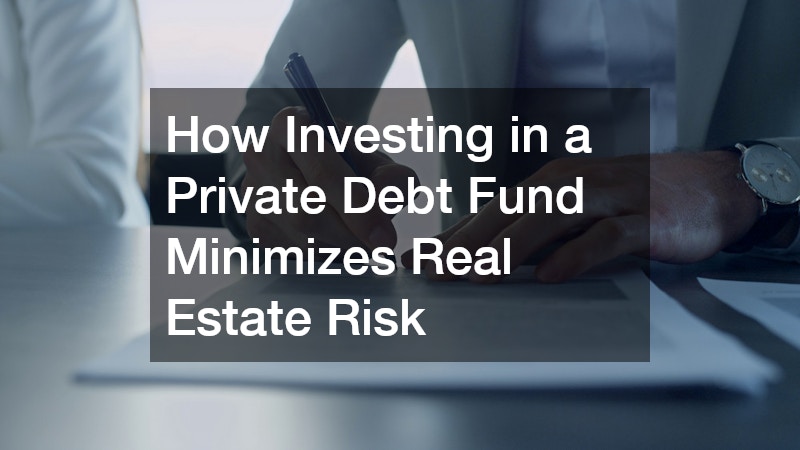In the world of real estate investment, minimizing risk while maximizing returns is a constant balancing act. Investors continuously seek strategies that provide a stable income stream without the extreme volatility seen in direct property investments. A real estate private debt fund offers an appealing avenue for such investors, enabling them to gain exposure to real estate while mitigating potential risks.
Private debt funds have grown in popularity due to their potential for consistent returns and lower risk profile compared to direct property ownership. By investing through these funds, participants can indirectly partake in real estate ventures while reducing their exposure to market fluctuations.
This article aims to explore the intricacies of private debt funds and how they serve as an effective strategy for risk management in real estate investing. We will delve into how these funds operate, the types of risks prevalent in real estate, and practical steps to initiate investment in private debt funds.
What is a Private Debt Fund and How Does it Work?
Private debt funds are investment vehicles that pool capital from various investors to provide loans for real estate projects. Unlike traditional real estate investments, which involve significant exposure to property market dynamics, private debt funds offer relative stability and predictable returns. They represent an intermediary between investors and real estate developers, providing the necessary capital for projects with an expectation of fixed income returns.
The core operation of a private debt fund involves lending to real estate projects, often at a higher interest rate than conventional financial institutions due to the specialized nature of the financing. These funds typically invest in senior-secured debt, junior debt, mezzanine debt, or sometimes in distressed debt, depending on the fund’s strategy and risk tolerance. This characteristic ensures that investors are shielded to some extent even in challenging market conditions.
Understanding the underlying mechanisms of private debt funds is crucial for investors looking to diversify their portfolios with minimal risk. The structured nature of these funds, combined with their ability to cater to both individual and institutional investors, makes them an attractive option in today’s complex real estate investment landscape.
What are the Types of Risks in Real Estate Investing?
Investing in real estate inherently comes with a set of risks that can affect returns. Market risk is one of the primary concerns, arising from fluctuations in property values due to economic forces, supply and demand dynamics, interest rate changes, and geopolitical events. These factors can significantly impact the performance of real estate investments.
Property-specific risk pertains to issues related directly to a particular property, including physical damage, regulatory compliance, tenant defaults, and operational inefficiencies. High vacancy rates or declining local markets can exacerbate these risks, leading to decreased property value and income.
Financing risk is another critical consideration, as it relates to interest rate spikes, refinancing challenges, and changing credit market conditions. If not managed properly, financing risk can lead to financial distress, particularly for highly leveraged investments. Private debt funds, by structuring investments as loans, help alleviate this risk by providing a more predictable return profile.
How Do Private Debt Funds Minimize Real Estate Risk?
Private debt funds mitigate real estate risk through diversification, securing loans against physical assets, and maintaining consistent yield generation. By spreading investments across various properties, sectors, and geographies, these funds can reduce exposure to localized market fluctuations.
Secured lending is a key component to minimizing risk in private debt funds. Loans are often backed by real estate assets, providing a safety net if borrowers default. This structure offers protection to investors, as they hold a claim on the property’s value, which can be realized through foreclosure if necessary.
Another risk-mitigation strategy employed by private debt funds is their focus on generating consistent yields. Given their typically higher position in the capital stack compared to equity investors, private debt funds prioritize income generation, ensuring investors receive regular interest payments and, thus, a stable income stream.
How Can Investors Get Started with Private Debt Funds?
For investors interested in entering the realm of private debt funds, understanding entry barriers such as minimum investment requirements and fund management fees is crucial. Thorough research into a fund’s history, strategies, and risk management practices will provide the foundation for informed decision-making.
Choosing the right private debt fund involves assessing one’s own risk appetite, investment goals, and market outlook. Due diligence is vital—investors should scrutinize potential fund managers’ track records, the sectors they target, and the strategic approach employed in selecting real estate projects.
To facilitate a successful investment, potential investors should consider practical strategies such as diversifying across multiple funds, consulting financial advisors, and staying informed about market trends. These steps, coupled with careful planning, will enhance the investor’s ability to navigate the complexities of private debt fund investment effectively.
Conclusion
Investing in a private debt fund presents promising opportunities for those aiming to mitigate real estate risk. These funds’ ability to offer predictable returns and reduced exposure to market volatility makes them a valuable addition to a diversified investment portfolio.
While private debt funds offer significant advantages, they are not without challenges. Investors must approach them with due diligence, weighing potential returns against the inherent risks, and ensuring alignment with broader investment objectives.
In conclusion, private debt funds serve as a strategic alternative for real estate investors seeking stability without forgoing potential returns. The key to success lies in a thoughtful selection process, strategic financial planning, and ongoing market awareness.


